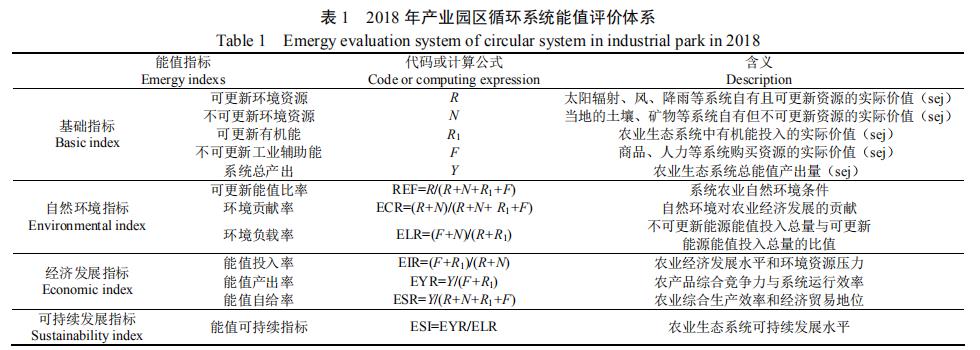1研究区概况及方法
1.1研究区概况
河北省某典型奶牛养殖产业园区占地面积2×105 m2,基于研究区域年太阳辐射5 016~5 852 MJ/m2,值牛产年平均气温15℃,分析年平均降雨量558.5 mm。业园园区内年养殖奶牛5 500头,区循养殖面积6.05×104 m2,展模建有日处理1 000 m3奶牛粪污的式评沼气工程一处,发酵工艺为CSTR,基于产生的值牛产沼气用于产热和发电以供给园区使用,沼渣用于生产有机肥,分析沼液作为种植业液态肥料施用,业园形成了农业废弃物多层次利用的区循循环农业系统。本研究以“奶牛养殖—CSTR湿法单相厌氧消化沼气工程”循环农业模式(模式Ⅰ)为研究对象,展模与同规模的式评湿法两相耦合厌氧消化(模式Ⅱ)、干法序批式厌氧消化(模式Ⅲ)、基于干法连续式厌氧消化(模式Ⅳ)3种沼气工程模式进行分析、比较和评价。
1.2指标体系构建
对园区进行实地调研,从能值流动、资源利用、环境负载和经济发展4个方面入手,建立了园区的循环农业系统的评价体系。通过对以沼气工程为纽带的种养结合循环系统涉及的不同资源及环节进行划分,将能值流量指标分为可更新环境资源(Renewable NaturalResources,R)、不可更新环境资源(Non-renewable NaturalResources,N)、可更新有机能(Renewable Organic Energy,R1)、不可更新工业辅助能(Non-renewable SupplementEnergy,F)和系统总产出(Yield,Y)5个部分组成(图1)。其中,太阳、风、雨水属于系统自身的环境资源,可更新有机能和不可更新工业辅助能属于人类对系统投入的经济购买能值。另外,在可更新有机能中,有一部分资源作为生产过程中的中间产物,是可在经进一步处理后在系统中重复利用的。
 结合园区奶牛养殖耦合沼气工程的特点,本研究主要选用能值投入率(Emergy Input Ratio,EIR)、能值产出率(Emergy Yield Ratio,EYR)和能值自给率(Emergy Self-sufficiency Ratio,ESR)对园区资源循环利用情况进行分析,采用可更新能值比率(RenewableEmergy Ratio,RER)、环境贡献率(Emergy ContributionRatio,ECR)和环境负载率(Emergy Loading Ratio,ELR)度量资源利用对环境的影响,同时参考综合指数评价方法,从中选取能值可持续指标(EmergySustainable Index,ESI)对该园区的循环农业发展进行综合评价。通过上述3类资源、环境、可持续发展的指标,构建了产业园区循环农业的综合评价指标体系(表1)。
结合园区奶牛养殖耦合沼气工程的特点,本研究主要选用能值投入率(Emergy Input Ratio,EIR)、能值产出率(Emergy Yield Ratio,EYR)和能值自给率(Emergy Self-sufficiency Ratio,ESR)对园区资源循环利用情况进行分析,采用可更新能值比率(RenewableEmergy Ratio,RER)、环境贡献率(Emergy ContributionRatio,ECR)和环境负载率(Emergy Loading Ratio,ELR)度量资源利用对环境的影响,同时参考综合指数评价方法,从中选取能值可持续指标(EmergySustainable Index,ESI)对该园区的循环农业发展进行综合评价。通过上述3类资源、环境、可持续发展的指标,构建了产业园区循环农业的综合评价指标体系(表1)。
 1.3研究方法及数据处理
1.3研究方法及数据处理
研究中湿法单相厌氧消化模式的原始数据都来自2018年对研究区的实地调研和资料收集,以园区现有沼气工程为纽带,以完整生产年度为期进行数据记录,以河北省统计局、河北省气象局等机构记录为基准对自然资源数据进行收集(表2)。研究中涉及的原始数据计算方法参考Odum、陈阜等学者的研究。考虑到初级自然资源的能值转换率在不同地区变化不大,选择Odum研究团队的能值转换率参数,对太阳光能、风能、雨水化学能等环境资源进行测算。化肥、农药等经济系统资源的贡献,采用《中国统计年鉴》、《中国农村统计年鉴》及河北省统计局公布的2018年相关数据进行测算。湿法两相耦合厌氧消化、干法序批式厌氧消化、干法连续式厌氧消化3种模式的数据通过实地调研和已发表文献中的相关工艺参数进行模拟测算后获得。
所有数据均用Excel整理和统计。
 声明:参考《农业工程学报》 2020年9月第36卷第17期,如涉及版权问题,请联系删除。
声明:参考《农业工程学报》 2020年9月第36卷第17期,如涉及版权问题,请联系删除。
相关链接:研究,厌氧,产物,农药